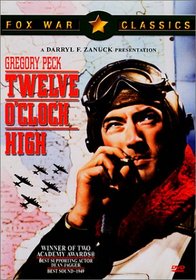| Actors: Gregory Peck, Hugh Marlowe, Gary Merrill, Millard Mitchell, Dean Jagger Director: Henry King Creators: Leon Shamroy, Henry King, Barbara McLean, Darryl F. Zanuck, Beirne Lay Jr., Sy Bartlett Genres: Action & Adventure, Drama, Military & War Sub-Genres: Classics, Drama, Military & War Studio: 20th Century Fox Format: DVD - Black and White,Color,Full Screen DVD Release Date: 05/21/2002 Original Release Date: 01/01/1950 Theatrical Release Date: 00/00/1950 Release Year: 2002 Run Time: 2hr 12min Screens: Black and White,Color,Full Screen Number of Discs: 1 SwapaDVD Credits: 1 Total Copies: 1 Members Wishing: 0 MPAA Rating: Unrated Languages: English, French Subtitles: English, Spanish |
Search - Twelve O'Clock High on DVD
  | Twelve O'Clock High Actors: Gregory Peck, Hugh Marlowe, Gary Merrill, Millard Mitchell, Dean Jagger Director: Henry King Genres: Action & Adventure, Drama, Military & War UR 2002 2hr 12min This gritty World War II action drama staring Gregory Peck, Oscar winner Dean Jagger, Hugh Marlowe, Gary Merrill and Millard Mitchell is seen as one of the most realistic portrayals of the heroics and perils of war. Convin... more » |
Larger Image |
Movie DetailsSimilar Movies
Similarly Requested DVDs
|
Member Movie ReviewsReviewed on 7/5/2025... "Twelve O'Clock High" is a 1949 film starring the venerable Gregory Peck about Air Force Brigadier General Savage who is tasked with whipping a bomber wing of misfits into battle-ready shape. My understanding (from IMDB trivia) is that the film is still used today as part of officer training programs in multiple military branches, and it's easy to see why.
It's not that the men are misfits necessarily, they just don't understand why they're fighting and what they're sacrificing themselves for. They don't always know the results of their bombing runs, and they don't understand why when they lose five planes, only three arrive to replace them. They identify as a "hard luck group." Savage shuts that notion down immediately, and begins to instill a sense of pride in the men. He has his favorites, of course, but he sincerely wants every man to succeed and put in "maximum effort." Comic relief is found in the character of Sgt. McIllhenny, who quickly gets demoted to private...then re-promoted back to sergeant...then demoted...then promoted...Savage eventually suggests that McIllhenny sew a zipper on his stripes. Eventually, the men rescind their transfer requests, and even ground-crew members start stowing away on the bombers to get a piece of the action. The conflict in the film arises from Savage needing to maintain his own sense of pride and optimism despite losses on bombing missions. The stress eventually does take its toll on Savage, and the end of the film reminded me of the final sequence in "Captain Philips" with Tom Hanks. I was gladly surprised to see such a frank depiction of PTSD in a film from 1949. The only real downside to the film is the final battle sequence which, while incorporating actual WW2 aerial combat and bombing footage, sets character development aside for most of that time. It's similar to the light saber fights in the newer Star Wars movies - there needs to be some sort of conflict or communication between the characters involved, not just well-choreographed shots of people swinging swords at each other. (See "The Princess Bride" or "Rob Roy" for better examples.) But I really can't criticize the film that much - veteran director Henry King has a patient and steady hand, and although some of the character interactions can be a little hard to follow sometimes, it is definitely worth a watch. Grade: A-minus |















